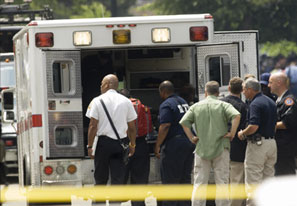
It’s often said that modern urban life can harden the human heart. Maybe so, but several months ago, I had an experience that cut in the opposite direction.
I was driving along “I” Street in Washington, headed for my gymnasium, not far from the Marine barracks on Eighth Street, in the Southeast quadrant of the city. Just after the Marine guard station in the middle of the block, the traffic—a big-box truck and the few cars in back and alongside it—had stopped. The truck’s driver-side door was wide open; but otherwise, nothing seemed amiss as the light at the intersection went from green to red to green again. I got out to see what I could—which was nothing, since the cars were in the way—and then angrily got on the horn to get people to move on. The truck didn’t budge, but the cars did. As soon as I approached the truck, I saw the body in the road: a woman, prone and with her face turned away from me, otherwise unruffled except for the obvious and massive trauma she had suffered from the truck’s blow to her head. Her death must have been instantaneous and must have occurred just moments earlier because no emergency or police vehicles were yet on the scene, and I noticed a Marine guard become agitated and dart from his post.
My first reaction was shame at my horn-blowing impatience: What were a few minutes lost in traffic compared with this awful end of a human life? There was nothing I could do but move on, since there was no doubt in my mind that the woman was dead, and the Marines were better able to help, in any case. But as I drove by, passing within just a few feet from her body, I couldn’t help thinking that something about her looked strange: in her right hand, she held a large and sensible cloth handbag. Her brown hair was cut in a sensible bob. Her shoes were sensible brown loafers. Her socks, too, were sensible and short and white, and her dress looked like Dorothy’s on the farm in The Wizard of Oz. Something about the way she had dressed suggested that she had done so with some help or according to a learned routine, and that she might have been developmentally disabled. Somehow that made the scene more heartbreaking: on her way to work, she must have been happy and proud, I thought, to have mastered her wardrobe, however devoid it was of womanly vanity.
It turned out that I was right. For days, I couldn’t get the disturbing scene out of my mind, and—stumbling, as I had, upon the end of her small world—I felt an odd sense of intimacy with a person I had never met. So I tracked down some news footage shot at the scene after the police and emergency personnel had arrived. Her name was Julie Phillips. She worked at the barracks cafeteria, through an agency that finds employment for people with disabilities. She was 44. And she had a good friend, an older man named Hubert Hackney, who told the news reporter that he worked with her and was surprised at how she died: “She always crossed at the corner,” he said, not in the middle of the block. “She was my friend,” he proclaimed, “and I am going to miss her.” I never found out what actually happened, and I don’t think the truck driver was judged to be responsible. It seems that Julie had just made a mistake in the exercise of her simple routine.
I think of Julie every time I go to the gym and drive by the spot where her life—her joys and her cares, whatever they were—disappeared. She wasn’t my friend, and, had she walked by me on the sidewalk, I probably would have taken no notice at all. But life, especially in the crowded city, connects us to others in ways and in depths we can never predict. We didn’t know each other, but I will never forget her.
